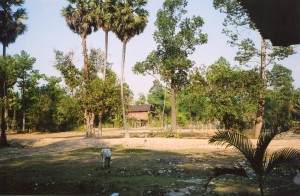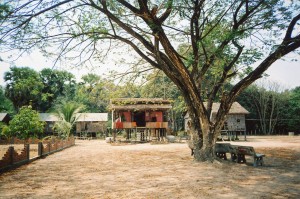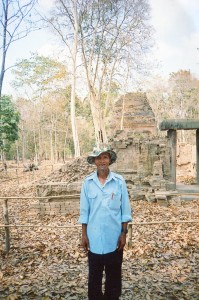In What Wat? How Was Angkor Wat Created? we saw that several things converged in the 9th century to make Angkor the base of a great civilization that would last more than 600 years. One more key ingredient was a great man called Jayavarman II.
Like Egypt’s King Sneferu, Jayavarman was an early ruler who did things his people never saw before (you can see The Road to Perfection in Ancient Egypt). Both men’s deeds became intellectual horizons throughout their cultures’ histories.
1. Jayavarman turned ideas of Mount Meru (the sacred mountain in the center of the universe–you can see Mount Meru, Everest on Steroids in Ancient India) that Indian merchants and priests brought into an expression of his authority. He proclaimed himself chakravartin (universal king–literally, wheel turner) in a lavish ceremony on top of the Phnom Kulen ridge which borders Angkor’s north. Khmers associated these uplands with Mount Meru and Indra, the storm god who ruled in his palace on its summit–an Indian Zeus.
This association of the king with Indra would stick. Thais adapted it when they later sacked Angkor in 1431 and 1432, and brought its priests and artists to their capital, Ayutthaya. Thais still associate their current king, Bhumibol, with Indra–Jayavarman’s footprints are very deep.
Many ancient Southeast Asian societies conceived of a sacred mountain and associated it with local nature spirits and ancestors. When Indians came, Khmers blended Mount Meru’s Hindu and royal symbolism with local ideas. They now had a dream team of concepts to ground royal authority in.
Hiram Woodward thinks that the Khmers were also putting Chinese royal symbolism into the mixture. Chinese emperors ascended Tai Shan to bring their realms in line with Heaven since the 3rd century BCE. Southeast Asians are known to have been present at some of these shindigs.
Khmers were probably blending concepts from multiple lands to make their own ideas robust. The sacred mountain, royal authority, local spirits and Hindu gods fused into a key conceptual horizon for the rest of Khmer history.
2. Ever restless, Jayavarman II established at least 5 capitals for his court. Like Ancient Egypt’s King Sneferu building 3 pyramids, he experimented many times to realize a big vision.
He finally settled on Hariharalaya (in today’s Rolous). This remained the capital for most of the ninth century until it was moved 15 miles northwest to Angkor. Jayavarman had found a place where he could control the Khmer economy. It was based on wet rice farming, and Jayavarman linked the symbolism of water and soil fertility with ideas of the sacred mountain.
His descendants would complete Angkor’s conceptual foundations by building its first great temples. They became models for Angkor Wat, and they make Rolous a must-see for visitors to Cambodia.
You can read about the water symbolism in What Wat? How Was Angkor Wat Created?
And you can begin to explore the architectural glories that Khmer kings would soon create in The Bakong.




Comments on this entry are closed.